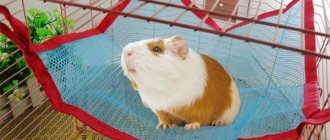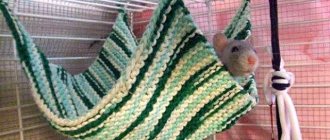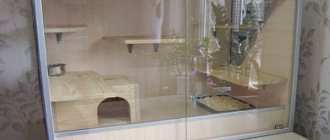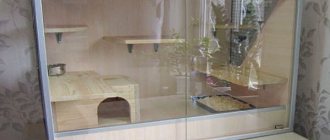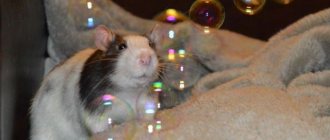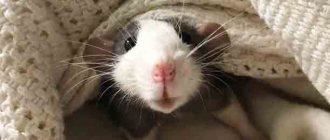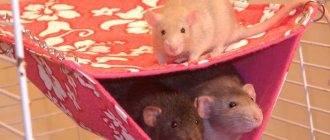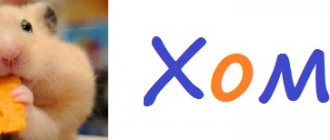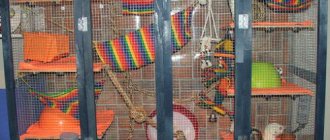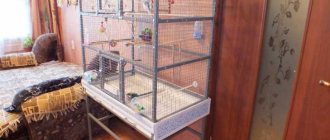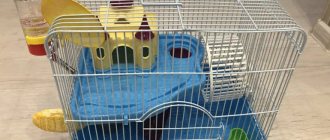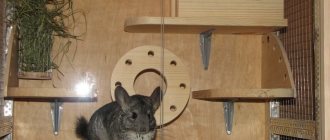The decorative rat is a fairly popular pet. These animals make contact easily, are well tamed, and are loved by both adults and children. In order for a rat to feel comfortable, grow and develop well, it is necessary to create suitable conditions for it. In addition to the feeder and water bowl, the pet’s cage should have ladders, shelves, wheels, houses, and hammocks of various shapes and sizes. Making a hammock for a rat with your own hands is quite simple. We will talk about this in the article.
Types of hammocks
Many rats like to sleep not on the floor of the cage, but on some elevation - this is a requirement of their natural instincts, a tribute to ensuring safety. In addition, such an accessory used by the animal for sleeping allows you to save space on the floor of the cage. Hammocks for small rodents can be of different shapes: traditional rectangular (square), rectangular (square) with a roof, a hammock in the form of a pipe, a hanging house, etc. Some of them are shown in the photo below.
In large cages where several pets live, hammocks of complex shapes, in several tiers, are often hung, as in the bottom photo.
Anyone can make hammocks for rats with their own hands.
Why does a rat sleep a lot?
Prolonged sleep in rats, especially older ones, is considered a physiological norm. However, if a very young animal, up to a year old, sleeps for days on end, it is worth thinking about the pet’s well-being. There may be several reasons for this behavior:
- Health problems. Rats are prone to developing tumors. Alarming symptoms should be: decreased motor activity, complete apathy, lack of interest in current events, decreased appetite, dulling of fur, partial or complete baldness, and reluctance to contact the owner. If at least one of the listed signs appears in combination with abnormally long sleep, it is necessary to show the animal to a veterinarian as soon as possible. Most likely the fluffy is sick. The doctor will examine the animal and prescribe appropriate treatment.
- Calm temperament. Phlegmatic people are found among both people and animals, including rats. Therefore, perhaps the animal feels great, sitting comfortably in a cozy house or hammock. And a few hours of wakefulness are enough for him to satisfy his basic needs.
- Passing the rehabilitation period. Rats have poor health, and they especially often suffer from tumor diseases. If the animal has undergone surgery to remove a tumor, in the first 2-3 days it will sleep almost around the clock until it completely restores its vitality.
- In some cases, a rat's prolonged sleep is not a pathology, but simply indicates that the furry is bored - there is no one to play with and communicate with. If the owner does not have the opportunity to devote at least 3-4 hours a day to the pet, then it will be necessary to place relatives in the animal’s cage. Rats are pack animals, so they constantly need communication.
- Sometimes the animal becomes lethargic due to an insufficiently balanced diet . Poor nutrition leads to vitamin deficiency and, as a consequence, to a decrease in vital energy. In this situation, it is enough to supplement the rodent’s daily menu with natural products (vegetables, fruits, berries, animal protein), as well as add specialized mineral and vitamin complexes to the feeder.
- For females, the cause of prolonged sleep can be pregnancy . During the period of bearing babies, the expectant mother becomes less mobile, nests, and prefers to rest more. Therefore, a pregnant female spends most of her free time in a state of sleep - accumulating strength and energy for the upcoming birth and feeding the offspring.
Also, the duration of a rat's sleep can vary depending on the time of year and weather conditions. Rodents are weather-dependent animals. Therefore, on the eve of rain or thunderstorms, they can fall into a short hibernation.
In addition, the vital activity of rats varies greatly depending on the season. In spring and summer, fluffies prefer to actively explore the world, and in autumn and winter they prefer to lie down, accumulating energy. Wild rats behave similarly in natural conditions.
Tips for making hammocks
Fans of decorative rats who have already made appropriate accessories for them with their own hands are advised to pay attention to the following nuances:
- The hammock should be quite spacious, approximately twice the size of the animal.
- It should be as harmless as possible, pleasant to the touch and have a neutral odor. The fabric should be soft. It is unacceptable to use metal mesh for rat hammocks. Even though a rat may chew on a fabric hammock, it is better to make it a new one. Metal is too dangerous to be injured, besides, it is hard and cold to the touch. The animal may simply find it unpleasant to be in it, and it will stop climbing into such a hammock.
- The hammock must be securely fastened. If your rat is large, it is advisable to hang it not on strings, but on hooks or carabiners. They can be purchased at specialized hardware stores. Some craftsmen use metal chains instead of ties, but there have been cases when rats got entangled in them and injured their paws.
Of course, hammocks, like houses and other accessories located in cages, should always be clean. This will help prevent the occurrence of many dangerous and unpleasant diseases of your pet.
Additional accessories for chinchillas
Placing an animal in a new cage is only the first stage of creating a cozy atmosphere for it. In order for a chinchilla to enjoy life, be healthy and active, its place of residence will need to be provided with additional details. What's on this list?
House
One of the mandatory additions to the cage. You can immediately buy a metal cage or a wooden one, or a profile display case with a house. And if you have purchased a display case, or the simplest metal cage, or you want to independently organize a place of residence for a South American rodent, you will need to provide a home for the pet as the main addition. This way the animal can climb into it at any time and rest. The size of the sleeping place is slightly larger than that of an adult chinchilla, because they like to lie down at their full height.
Cozy homemade house for a rodent
Feeder
An essential element of the cage, which is best attached to the bottom or wall of the cage, and should also be washed systematically. There are no restrictions on materials. The most convenient option is a plastic food bowl. The main thing is that it has a comfortable shape for the animal and is moderately deep.
Feeder attached to the cage wall
Drinking bowl
Another important accessory that will need to be attached to the bars of the wall or door. It should always contain clean and fresh water, and the structure itself should not allow leaks. Unlike the feeder, it cannot be placed on the floor, otherwise the water may become contaminated. The breeder can choose one of two common drinker options - ball or nipple.
It is better to attach a glass drinking bowl to a cage
It is necessary to select the one that will be convenient for a particular pet. Another important nuance is that you should not buy a plastic drinking bowl, otherwise the chinchilla can quickly chew through it. The best option is glass.
Sennitsa
She's a feeder with hay. The latter must be present in the chinchilla’s diet to maintain the health of the animal. If you leave hay just like that on the floor, it will soon be naturally distributed throughout the cage. But you should also be careful with the design of the hay feeder. It is best when it is a separate small house. An alternative is to use a small mouse or hamster running wheel that remains closed after the hay is added. The structure will need to be secured first so that the chinchilla does not get hurt.
The best option for feeding hay to a rodent
Stone for chinchilla
It will be needed so that the rodent can periodically sharpen its teeth with its help. Typically, a salt or mineral stone is used for these purposes, which is placed in the same way as a drinking bowl, on the walls of the cells. Otherwise, it may get lost, but it will always be in sight and freely accessible to the pet.
Mineral stone for grinding teeth
Litter tray
Of course, you will need to organize a toilet in the cage, since the chinchilla is a fairly clean animal. Although it was previously mentioned about the need for a pull-out tray under the cage, it is also better to install the tray inside the cage or display case. This will make cleaning much easier and more convenient. Plus, the cage won’t get too dirty or clogged.
For more convenient cleaning and keeping the cage clean, install a chinchilla tray
Sand bath
We have already focused on the cleanliness of chinchillas. In order for them to keep their fur clean, they will need clean sand, as it is preferable to water for animals
A small container is enough, but it should be comfortable for the animal to roll over in it.
Rodent prefers sand baths
Toys
They can be called a sign of a good, caring owner. Moreover, some of them do not have to be purchased at a pet store. What entertainment is suitable for restless rodents?
- Running wheel.
It is better to purchase products made of plastic rather than metal, since such toys are unsafe for chinchillas. A place for active running is installed on the wall of the cage. Wheel for active entertainment - Small tunnels made of plastic.
Pets will be happy with this entertainment. The more interesting the pipe maze, the more interesting it will be for the animal to explore it. - Wooden Toys. In addition to games, the animal will be able to gnaw on it without harm to health.
We recommend hanging a hammock in a cage as a toy and at the same time a place to relax.
What can you make a hammock from?
For those who do not like or do not know how to sew, the following tips may be useful. So, what can you use to make the simplest hammock for a small rodent?
For this you can use:
- An old pillowcase or towel, folded in half (four times).
- An old unnecessary hat.
- An old headscarf or neckerchief.
- Unnecessary socks.
- Wool hats that have gone out of fashion.
These objects are simply attached to the corners of the cage at a suitable height, taking into account that the rat can freely get into and out of the hammock.
Next, we will consider options that require at least minimal sewing skills.
for guinea pig
A straight hammock is created exactly like a corner one, the difference is that for this model the piece of fabric must be square.
If you want to make a hammock from filler, then you will need a piece of fabric 30x60cm. We fold it in two with the front side facing inward. It turns out that one side is solid, and we will have to sew the other three. To increase the strength of the seam, you should imitate machine stitching, but you can also use any other seam that is more or less successful. Having finished sewing both sides, we turn the future hammock inside out, thereby hiding the seams. Next, we arrange the foam rubber inside the product, straightening it well. Instead of foam rubber, you can use other fillers, but you should remember that guinea pigs will sooner or later stain the hammock and it will need to be cleaned and washed periodically. Therefore, it is necessary to select a filler taking into account these factors. Next we sew up the third side of the product.
When the base of the hammock is ready, we proceed to sewing the ties. Next we use the laces. They are folded into two and the middle of each lace is sewn to one of the sides of the hammock. Once sewing is complete, you should have a hammock and eight string ties. The entire process of creating a homemade hammock is over.
You can also use regular paper clips instead of laces. To do this, a small hole is made in each corner of the hammock and sewn with threads to strengthen it so that the hammock does not tear during the game.
Hammock suspension
At what height should the hammock be installed? Should it be tightened or should it sag? Focus on your pet. Hang the hammock so that the pig can climb on it without much effort, and then experimentally select the desired height and sagging of the hammock. Under no circumstances should you try to put your pig in a hammock yourself; it may get scared; let it climb into it on its own over time. And to speed up this process, you can add your pet’s favorite treats to the hammock.
Video on how to sew a hammock for guinea pigs:
Hammock tube
Do-it-yourself rat hammocks in the shape of a pipe, like any other, can be sewn from cotton or synthetic fabric. Caring owners sew them double: on the outside - decorative fabric, on the inside - soft fleece, so that the animal feels comfortable touching its surface. However, not everyone has time for intricate sewing.
The easiest option is to take a piece of sleeve from unwanted clothing or cut a piece from old trousers. The easiest way to make a hammock for a rat is from jeans. This fabric is durable, practically does not fray, and the finished product will have an attractive appearance. Strong ribbons are sewn at the corners. They tie themselves to the cage - the hammock is ready.
Shallow pool
A shallow pool will provide a lot of fun for your rodents in the summer. Cool splashes, a chance to dig around and look for treats!
- Use a heavy flower pot stand or bowl.
- Add some smooth pebbles to the bottom - these can be found in garden stores or aquarium supplies.
- Fill the container with water.
- Scatter some frozen peas or corn under the pebbles.
- Let the rats in.
Your pets will love rummaging through the pebbles looking for treats! At the same time, they will escape the summer heat in cool water.
Simple rectangular hammock
You can make a hammock for a rat with your own hands from classic-shaped jeans - rectangular, but double, as in the photo below. This way it will be stronger and last longer.
You can not sew ribbons to the corners of such a hammock, but thread them into the holes made, reinforced with eyelets. If you don't have a punch, you can take the product to a workshop for this.
A rectangular hammock for a rat with your own hands (the pattern is given below), two-layer, with a lining, is quite easy to sew. The fabric can be taken in one or contrasting colors. The edges need to be folded and stitched by machine or processed by hand.
This pattern is universal; it is also suitable for other rodent pets - degus, chinchillas, etc. Only the sizes of the pieces of fabric differ: optimal for a rat hammock is 25 x 30 (30 x 35) centimeters. In such a nest your pet will feel comfortable and cozy. Also pay attention to the size of the rat cage, as it may be slightly larger or smaller.
Games with you
If you have free time, be sure to play with your pet.
- Throwing a rat. Pick up the rat and carefully place it on a soft surface such as a pillow, sofa or bed. Most rats will love this and will come running back to repeat the procedure. You can try to increase the throwing distance, but always make sure that the landing is soft and safe.
- Fighting with the hand. Let your hand be that of a hunter who has caught up with his prey and began to fight with it. When fighting a rat, do not hurt it; you can throw it on its back and scratch its abdomen with your nails. Remember that your rat has to win sometimes too.
- Mutual care. Clean your rat. In turn, let her comb your eyebrows and hair, give you a manicure, and remove bandages, earrings or rings.
- Rat rolling. Place the rat on its back and press its paws to its sides. Roll it from side to side. At the same time as you roll, scratch and tickle her tummy.
- Joint affairs. Let your rat finish your ice cream, chew a little on the book you're reading, walk around the TV remote and change channels. Do regular household chores with her.
Rectangular hammock made of fleece strips
If you have time and are eager to make something intricate for your pet, try making a hammock woven from individual strips of fleece fabric. To do this, you will need to take two fleece rectangles (preferably in different colors) of the sizes indicated above. The rectangles are cut into separate strips approximately 3 centimeters wide and intertwined, as in the picture below.
They are secured with pins, after which the edges of the strips are folded on both sides and stitched. Now they need to be processed. To do this, take a strip of durable fabric of a suitable color, fold it, smooth it and make a edging of the edges (stitched on a typewriter).
Eyelets are installed on the corners of the finished product. Strong ribbons of a suitable color are threaded through them. To increase the strength of the hammock, it is advisable to stitch it crosswise in the middle or diagonally so that the strips diverge less.
The appearance of the finished hammock is presented below. It is more difficult to sew such a hammock for a rat with your own hands, but the result is worth the effort: the product looks bright and impressive.
Sports equipment
You can make entertainment accessories and sports outfits at home; they will not let your pet get bored.
So, you will need to prepare the following materials:
- Chain with rings.
- Twine.
- Round wooden sticks, only processed.
- A small piece of faux fur.
- Glue, but you will need a non-toxic, special one that will not harm animals.
- Twisted rope.
- A jigsaw, maybe a small wood saw.
- Drill, thin drill.
At the first stage we make a wooden staircase. First, you need to use a jigsaw or saw to cut several pieces from the wooden sticks. Next, we make holes on two long sticks using a drill and insert small pieces into them, secure them with glue. Metal rings are attached to all four sides of the ladder.
At the second stage we make a rope ladder. You will need to take several pieces of wood of the same length. Holes are made in each segment on both sides; they must be through. Next, string is threaded through the holes and secured with a knot. There is no need to make large distances between steps.
The third stage is a hammock; no pattern is required. Take a piece of fur, fold it, you need to sew it with the fur inside. Next, we turn it inside out through the remaining gap, sew loops to the corners into which metal rings with a chain are inserted.
And at the last stage we attach these beautiful and useful accessories to the cage.
Knitted hammock
Those who know at least the basics of crochet can knit a hammock with their own hands. Such a product will be denser and stronger than many options. To make it, take a size 4.5 hook and threads of a suitable size. First you need to knit a 15 by 20 centimeter rectangle using single crochets. Afterwards, it is tied around the edges with single crochets, and ribbons are tied from the four corners with air loops to secure the hammock in the cage. The process of making such a knitted hammock can be seen in the video below. This is a fairly simple and quick option even for novice needlewomen.
How to train a rat to sleep at night
Some owners of decorative rats do not mind that their pets are active at night. Others are not happy that fluffies create a lot of noise and interfere with the rest of the entire household at night.
This problem can be dealt with by adjusting the animal’s rhythm of life to daytime activity with predominant sleep at night. The following steps will help train your rat to sleep at night:
- Designate a room with moderate noise levels for the rat to live in. On the one hand, the pet should not feel threatened by emanating sharp sounds. On the other hand, the presence of minor noise during the daytime will let the fluffy understand that now is not the time to rest.
- Maintain artificial lighting during the day. Rats do not tolerate bright sunlight quite well. But dim lighting from a lamp is perfect for ensuring that your pet sleeps as little as possible during the day. At night, on the contrary, you will have to completely turn off the lights in the apartment. This signal will tell the animal that now is time to sleep.
- Feed the rat at a clearly established time, of course, only during the day. The pet will wait for an hour to feed. At the same time, he definitely won’t sleep. The main thing is regularity; the nutritional schedule must be followed no matter what the conditions.
- Organize your pet's leisure time so that he doesn't get bored. For example, add 2-3 relatives to the fluffy. The pet will frolic happily with its cage neighbors, and the sleepy mood will fade into the background. It is also recommended to install as many different exercise equipment as possible for the animals to play with, so that the rats have something to occupy themselves with.
The entire process of getting used to the new regime will take 3-4 weeks. All this time you will need to act systematically, observing each of the points listed above. The main thing is not to get angry or raise your voice at the rat if it suddenly falls asleep at the wrong time. Moreover, you shouldn’t wake her up. Such behavior will be absolutely incomprehensible to the animal and can put it in a stressful situation, so you need to act gently and patiently.
It is worth noting that after moving to a new place, a decorative rat may lose its sleep and wakefulness patterns. Therefore, it is better to avoid long trips with your pet, otherwise you will have to retrain your fluffy all over again.
How and how much a domestic rat sleeps, why a pet sleeps a lot and does not wake up for a long time are questions that are of great concern to novice breeders. To avoid unnecessary worries about your new pet, it is better to familiarize yourself with the rhythm of life of rodents in advance.
Source
Chew toys
When pet rats get bored, they start chewing on something. To prevent them from chewing on your furniture, blankets and carpets, make your own chew toys for them.
- Walnuts in shell. The hard shell will not allow you to quickly eat the nuts and will occupy the teeth of rodents.
- Boiled chicken or beef bones.
- Wooden chew toys (not pine ones). You can buy such toys at a pet store, or you can cut disposable wooden sticks yourself. A popsicle stick works well, or you can even leave a little of the treat on it. Your tailed friends will thank you for this.
- Dog biscuits are hard, low in protein and fat.
- Baby crackers for teething.
- Wine corks.
- Cardboard boxes are a convenient house and a chewing toy in one.
